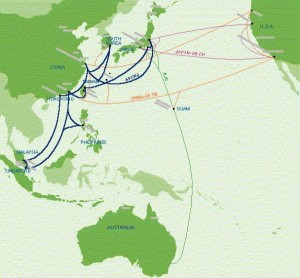Slow Internet access for PLDT users
A segment of the Asia-Pacific Cable Network 2 (APCN2) undersea cable network between China and Taiwan suffered a serious cable fault on Wednesday, causing Internet traffic to be rerouted onto other undersea cables and slowing Internet access for some users in Southeast Asia.
At about 10:50 a.m. on Wednesday, local time, an alarm signaled a cable fault on Segment 7 of APCN2, which connects Hong Kong and Shantou, China. The disruption caused a temporary loss of service on the undersea link but all customers that use the cable were soon shifted to capacity on other cables, according to a source familiar with the situation.
The APCN2 cable is owned by a consortium of 26 telecom operators from 14 different countries. The cable links Singapore, Malaysia, the Philippines, Hong Kong, Taiwan, China, South Korea and Japan.
The exact cause of the APCN2 fault was not immediately known. The alarm indicated the disruption was caused by a “single point of failure,” which suggests a variety of possibilities, including a technical failure or a cable cut,
The incident was likely the main reason that Internet access appeared slower for some users in Singapore on Wednesday,
Undersea cables are used to transport much of the world’s Internet traffic and can be easily damaged by natural disasters or other causes. In 2006, a powerful earthquake off the southern coast of Taiwan damaged several cables and slowed Internet access to a crawl for users in Southeast Asia.
APCN2 cable route
Singapore Telecommunications (SingTel), which is an investor in APCN2, said its users may experience slower Internet access than normal to some U.S. Web sites, blaming the APCN2 fault on damage caused by Typhoon Morakot.
“The [APCN2] consortium members have started restoration works, and our engineers are in the process of diverting Internet traffic to other cable systems. We expect the situation to return to acceptable levels within the next 24 hours,” SingTel spokesman Chia Boon Chong, said in an e-mail statement.
A spokesman for Starhub, another Singapore ISP that holds a stake in the cable, did not return a phone call seeking comment.
The fault that hit APCN2 on Wednesday follows two other service disruptions that recently hit the network. One disruption affected APCN2 Segment 7, between Hong Kong and Taiwan, and the other affected APCN2 Segment 1, which connects Singapore and Malaysia. However, both of these disruptions were deemed to be “relatively minor” compared to the disruption that took place Wednesday morning,
The cause of the two earlier faults on APCN2 was not immediately clear.
APCN2 isn’t the only Asian undersea cable currently suffering from a service disruption
“The Cable & Wireless Real Time Operations Team have logged multiple cable breaks on APCN2, APCN, EAC and SMW3 in Asia Pacific — specifically, near Taiwan. Network traffic flow has been adversely affected in and out of the region as a result,” said Gavin Tait, director of Asia network planning and implementation at Cable & Wireless, in an e-mail statement provided by the company.
None of Cable & Wireless customers were affected by these failures, he said.
Efforts are currently underway to repair the East Asia Crossing (EAC) undersea cable after it experienced “double faults” off the coast of Taiwan last weekend, according to Roland Lim, a spokesman for Pacnet, which owns EAC.
The first sign of damage to the EAC cable off the coast of Taiwan came on Aug. 9 at 1:37 a.m., local time, when an alarm signalled that service on EAC Segment D, which links Taiwan and Hong Kong, had been disrupted, Pacnet said in an Aug. 10 Network Event Notification that was obtained by IDG News Service. At the time, traffic on Segment D was transferred to EAC Segment C. However, Segment C suffered a second disruption roughly twelve hours later.
The cause of the faults that hit the EAC cable between Hong Kong and Taiwan is not yet known, but the damage happened at about the same time the southern part of the island and China’s southern coast was being pummeled by one of the most powerful typhoons to strike in recent memory. There were no earthquakes recorded by Taiwan’s Central Weather Bureau at the time when the disruptions took place.
Updated:
According to a notice sent by Malaysian telco, TM Net, the cable fault was traced to segment 7 of the APCN2, which stretches between Shantou, China and Tanshui, Taiwan. TM Net traced the outage to Typhoon Morakot, which hit the region over the weekend.
Additionally, segment 1 of the APCN2 is also currently under repair. Repairs on segment 7 are expected to commence after work on segment 1 is completed.
TM Net said the repairs are expected to be completed by late evening Aug. 13.
Singapore operator, SingTel, confirmed the cable fault in an e-mail to ZDNet Asia, saying the APCN2’s consortium members have started restoration works and are diverting Internet traffic to other cable systems. It said the situation is expected to return to “acceptable levels” within the next 24 hours.
A status update posted on InternetTrafficReport.com showed SingTel’s Singapore gateway registered a score of only 34 points, compared to the global average “health” of network connections, which was 86 points as at 3pm Singapore time on Wednesday.
way Back in 2006, the APCN2 was taken out by a powerful earthquake in Taiwan. Internet access was reportedly badly disrupted and halted in some parts of Asia after the quake.

